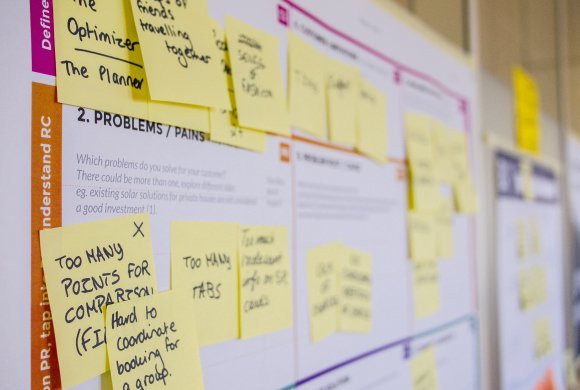When it comes to change, we all fall within a range from looking for any excuse to make a change, to being completely change-averse and trying desperately to keep things the same. Between these extremes, most people fall somewhere slightly left of centre. They don’t seek change for its own sake, and often need a compelling, convincing argument to make a change.
In a dynamic global culture where change is almost the only constant, it can be frustrating for business owners and leaders when employees and even managers, resist change or appear to need far more information, lead time, and adjustment time than there is to give. An unsuccessful change effort can lead to decreased productivity, morale, and profit – the impact of which can lag on for months or even years.
“A resilient organization is one that can effectively innovate, adapt and perform in the face of adversity (not just in good times).” says Executive Coach Maureen Moriarty.
“Resilient organizations often bounce back even stronger when stressed versus being flattened by their own inability to change.”
So how can organizational leaders ensure that necessary changes are made successfully? How can they minimize resistance and ensure quick buy-in and support from employees and managers? The answer may be easier than you think – connect them with the WHY.
Change is rarely about just taking on something new. There is almost always an element of letting go of what was in order to take on what will be. This is significant for many people. They are afraid of how change will impact them. Many of them will be required to move well outside their comfort zones as a result of the change. The first question out of their mouths is often WHY? Why do we need to change? Why can’t we leave things the way they are?
Why is one of the most natural responses to change – we’ve been asking WHY since we were in Kindergarten! In his ground-breaking book, Start With Why, anthropologist and author Simon Sinek proposes that what makes people respond to things on an emotional level is a connection to the WHY. (His Ted Talk on how great leaders inspire action is worth the 17 minute investment:
WHAT
Every organization on the planet knows WHAT they do. These are products they sell or services they offer.
HOW
Some organizations know HOW they do it. These are the things that make them special or set them apart from their competition.
WHY
Very few organizations know WHY they do what they do. WHY is a purpose, cause or belief. It’s the very reason your organization exists.
Simon Sinek, Start with Why
“People don’t buy (or buy in) to what you DO,” says Sinek. “They buy WHY you do it.” According to Sinek’s research, for most successful endeavours, companies, and leaders, in recent history, the consistent theme has been the ability for leaders to communicate their compelling WHY. When people understand and connect to WHY, they quickly and easily buy into the HOW and the WHAT. So how does this connect to helping people in your organization better respond to change?
Most leaders, according to Sinek, communicate from the outside of the circle, in to the centre. They start with the WHAT. In reference to implementing a change, it might look like this: “OK team, here’s what we are going to do . . . “ Sometimes, they move to the HOW. “Now that you know what we’re doing, here’s how we’re going to do it . . . “. Very few leaders, however, get to the WHY, and that’s the most important part. In fact, he suggests that 50% of organizational leaders don’t even know their WHY. It’s the part that creates an emotional connection that will motivate people to either come on board or put up roadblocks. The way to inspire action, he says, is to start in the circle’s centre, and move out.
Following is an example of how a software company might communicate an impending change from the inside out.
WHY: “Our vision is to be the most innovative productivity software company in the world. It’s what drives us and makes our customers successful. Because we are committed to maintaining the competitive advantage that allows us to keep being the go-to platform for business customers, we need to make some major adjustments to our product offerings in the next 12 months.”
HOW: “This means you’re going to see some significant changes to job assignments and responsibilities, an increase in productivity expectations, and some pretty tight timelines. Rest assured we’ll work together to create an effective workflow where everyone is working to their best strengths. It might be an exciting opportunity for all of us to learn new things.”
WHAT: “At the end of 12 months, we plan to have evaluated all our software products and made updates and revisions where necessary, with little to no interruption to customer service.”
Imagine how differently employees might have responded if the WHAT message had come first, and/or if that was the ONLY message they got. They would likely have responded with fears around what this would mean for individual jobs, worry about increased workloads and work stress, assumptions about how it was going to be accomplished and the impact it would have on them. In other words, resistance. It would result in slowdowns, questions, and whether intentional or not, sagging productivity and morale.
Starting with WHY the change needs to happen at the beginning of your communication process isn’t the only thing you need to do when implementing a change. There are many other change management strategies that can help you develop a plan for moving from where you are to where you want to go. However, having the emotional buy-in from your team – or at the very least, their understanding of WHY the change is happening, will pave the way for a smoother, faster, more effective transition.
As HR professionals we often carry the responsibility of assisting Executives with navigating the inevitable changes that our organizations must implement, with the people they affect. Using the principle of the Golden Circle, we can influence top leaders in our organizations to understand why the WHY is so important and the dramatic impact communicating it effectively it can have on the success or failure of change efforts within the organization, and on its bottom line.




